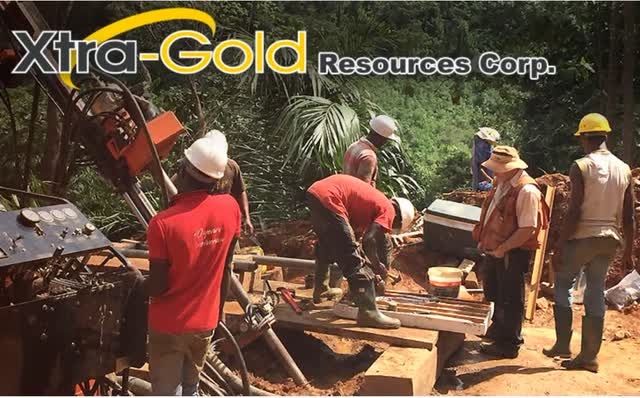Xtra-Gold defines new gold zone 300 metres NW of Double 19, expands Boomerang zone
 Xtra-Gold Resources Corporation
Xtra-Gold Resources Corporation
Xtra-Gold Resources Corporation has announced additional assay results from its current resource expansion target generation programme within the Zone 2 – Zone 3 maiden mineral resource footprint area, including a newly defined gold zone (“Twin Zone”) occupying a parallel fold structure in close proximity to the Double 19 deposit on the Company’s wholly-owned Kibi Gold Project, located in the Kibi – Winneba greenstone belt (the “Kibi Gold Belt”), in Ghana, West Africa.
Today’s drill results, according to a statement issued by Xtra-Gold, correspond to 23 diamond core boreholes totalling 3,739 metres completed by the Company’s in-house drilling crews from mid-March to late June 2021; with a total of 121 holes (16,743 metres) drilled to date since the program’s initiation in September 2019.
The assay results include the following highlights:
- 65.0 metres grading 1.03 grammes per tonne (“g/t’) gold, including 2.42 g/t gold over 13.5 metres, from a down-hole depth of 33 metres in #KBDD21411 and 43.1 metres grading 0.75 g/t gold, including 3.65 g/t gold over 3.0 metres and 1.29 g/t gold over 9.0 metres, from a down-hole depth of 28.5 metres in #KBDD21402 (Boomerang Zone – Fold Hinge).
- multiple gold intercepts over 87 metre core-length from a down-hole depth of 68 metres in #KBDD21400, including: 0.59 g/t gold over 7.0 metres, 0.51 g/t gold over 15.0 metres, 1.51 g/t gold over 5.0 metres, and 1.28 g/t gold over 11.0 metres (Boomerang Zone).
- 7.3 metres grading 1.93 g/t gold from a down-hole depth of 70.7 metres in #KBDD21409 and 15.0 metres grading 1.02 g/t gold, including 1.44 g/t gold over 6.2 metres, from a down-hole depth of 99.0 metres in undercut hole #KBDD21410; approximately 50 metres downdip of the #KBDD21409 intercept (New Twin Zone) - gold mineralisation now traced over an approximately 215-metre trend-length and 80-metre width of fold structure, and down to 165-metre vertical depth at Boomerang Zone.
- typical Kibi-type Granitoid-hosted gold mineralisation traced over an approximately 210-metre trend-length of fold structure and down to 105-metre vertical depth at newly defined Twin Zone; with zone occupying parallel fold structure to Double 19 deposit.
Mr James Longshore, President and CEO remarked: “The positive drill results announced today for the Boomerang and Twin zones validate our enhanced drill / trench targeting approach through detailed 3D modelling of favourable litho-structural settings analogous to the existing Zone 2 – Zone 3 gold deposits”.
“The newly defined Twin Zone occupying a parallel fold structure within 300 metres of the Double 19 deposit further demonstrates the resource expansion potential within the relatively untested Zone 3 of the Kibi Gold Project. We are confident that with continued scout drilling targeting untested segments of modelled fold structures along the over 2.5-kilometre trend-length of the Zone 2 – Zone 3 Granitoid-hosted gold system new discoveries will be made.”
The maiden Kibi Gold Project mineral resource estimate (October 26, 2012) encompasses the Big Bend, East Dyke, South Ridge and Mushroom deposits in Zone 2 and the Double 19 deposit in Zone 3.
In aggregate, these five gold deposits lying within approximately 1.6 kilometres of each other are estimated to encompass an indicated mineral resource of 3.38 million tonnes grading 2.56 g/t gold for 278,000 ounces of contained gold and an additional inferred mineral resource of 2.35 million tonnes grading 1.94 g/t gold for 147,000 ounces of contained gold (@ base case 0.5 g/t cut-off). The Zone 2 – Zone 3 maiden mineral resource represents the first-ever mineral resource generated on a lode gold project within the Kibi Gold Belt.
Gold mineralisation is characterised by auriferous quartz vein sets hosted in Belt-type granitoids geologically analogous to other “Granitoid-hosted” gold deposits of Ghana, including Kinross Gold’s Chirano and Newmont Mining’s Subika deposits in the Sefwi gold belt.
The drill results correspond to the latest 23 boreholes (3,739 metres) of an ongoing exploration initiative geared toward the generation of new resource expansion targets within the Zone 2 – Zone 3 maiden mineral resource footprint area of the Kibi Gold Project. With the drilling designed to follow up on early-stage gold shoots / showings discovered by previous drilling / trenching efforts (2008 – 2012), test down-plunge extensions and/or fold limbs of existing resource bodies, and to test prospective litho-structural gold settings identified by recently completed 3D geological modelling. A total of 121 boreholes totalling 16,743 metres have been completed since the initiation of the Zone 2 – Zone 3 resource expansion drilling program in late September 2019.
The present 23 diamond core boreholes were completed by the Company’s in-house drilling crews from mid-March to late June 2021 (#KBDD21392 - #KBDD21414), including: 8 resource expansion holes (1,646.5 metres) on the Double 19 deposit, 7 follow-up holes (1,107 metres) on the Boomerang Zone, and 8 holes (985.5 metres) on the recently identified Twin Zone).
The present drill results include 7 holes (1,107 metres) on the early stage Boomerang Zone located at the southwestern extremity of Zone 3, approximately 1,500 metres to the southwest of the current Zone 2 gold resource footprint. Recent 3D litho-structural modelling indicates that the Boomerang Zone gold mineralisation occupies an inferred NE-plunging, tight to isoclinal, anticlinal fold hinge zone.
With the mineralisation preferentially occurring along the contacts between the stacked granitoid – metasedimentary rock units and/or internally within the fractured granitoid. The drilling targeted the modelled NE-trending anticlinal fold structure with SE-trending, steeply-inclined (-70o) boreholes, including two drill fences spaced approximately 80 metres apart, to follow up on strong 2020 drill intercepts and to further define the geometry / attitude of the fold structure.
Previously reported mineralised intercepts from holes #KBDD20335 and #KBDD20338, consisting of a SW-trending drill fence drilled along the apparent axis of the fold structure, include 43.5 metres grading 1.21 g/t gold, including 2.16 g/t gold over 7.5 metres and 4.3 g/t gold over 6.0 metres, from a down-hole depth of 3.0 metres in #KBDD20335 and 24.0 metres grading 1.35 g/t gold, including 1.99 g/t gold over 9.0 metres, from a down-hole depth of 56.5 metres in undercut hole #KBDD20338; approximately 30 metres down plunge of the #KBDD20335 gold intercept (see the Company’s news release of September 8, 2020).
Holes #KBDD21402 and #KBDD21411 drilled across the apparent NE-trending fold hinge zone, perpendicular to the #KBDD20335-338 drill fence, returned mineralised intercept highlights of 43.1 metres grading 0.75 g/t gold, including 3.65 g/t gold over 3.0 metres and 1.29 g/t gold over 9.0 metres, from a down-hole depth of 28.5 metres and 65.0 metres grading 1.03 g/t gold, including 2.42 g/t gold over 13.5 metres, from a down-hole depth of 33 metres, respectively.
The northeastern #KBDD21393-397-400 drill fence returned a mineralised intercept highlight of 18.0 metres grading 1.04 g/t gold, including 2.59 g/t gold over 4.5 metres, from a down-hole depth of 45.0 metres in hole #KBDD21397. With hole #KBDD21400 yielding multiple auriferous intercepts over an 87-metre core-length from a down-hole depth of 68 metres, including: 0.59 g/t gold over 7.0 metres, 0.51 g/t gold over 15.0 metres, 1.51 g/t gold over 5.0 metres, and 1.28 g/t gold over 11.0 metres. With the present Boomerang Zone drilling efforts gold mineralisation has now been traced over an approximately 215-metre trend-length and 80-metre width of the anticlinal fold structure, and down to a vertical depth of approximately 165 metres.
The drill results include 8 scout holes (985.5 metres) on the newly defined Twin Zone appearing to be emplaced along a parallel anticlinal fold structure located approximately 300 metres northwest of the Double 19 deposit. This target was originally identified in 2011 during access road construction with follow up trench #TKB062 yielding 1.25 g/t gold over a 22.0-metre trench-length.
The target was subsequently tested by two boreholes in 2012 with hole #KBDD12196 returning a mineralised intercept of 17.0 metres grading 0.19 g/t gold; with the WSW-trending boreholes testing the zone’s internal easterly-dipping vein packages rather than targeting the NE-trending, gold mineralisation controlling, fold structure.
As part of an ongoing exploration initiative geared towards the ground-proofing of prospective litho-structural gold settings generated by 3D geological modelling, the target was subjected to additional trenching
to the east of the original #TKB062 trench in March 2021, with trench #TAD050 and road cut #ADRS018 yielding channel sample intercepts of 18.0 metres grading 0.52 g/t gold, including 1.5 g/t gold over 5.0 metres, and 19.0 metres grading 0.59 g/t gold, including 2.33 g/t gold over 1.0 metre, respectively.
The present drilling targeted the modelled NE-trending, mineralisation controlling, anticlinal fold structure with two SE-trending drill fences, spaced approximately 100 metres apart, to further define the geometry / attitude of the fold-structure, the host diorite body, and the gold-bearing vein system. The southwestern #KBDD21404-406-407-412 drill fence, centred between the #TAD050 trench and #ADRS018 road cut, traced the moderately NW-dipping mineralisation zone over an approximately 90 metre down-dip distance from surface (~65 m vertical), including mineralised intercept highlights of 17.0 metres grading 0.32 g/t gold, including 4.16 g/t gold over 0.5 metres from a down-hole depth of 56.5 metres in #KBDD21407 and 10.6 metres grading 1.01 g/t gold, including 2.02 g/t gold over 2.7 metres, from a down-hole depth of 72.4 metres in undercut hole #KBDD21412; approximately 25 metres downdip of the #KBDD21407 intercept.
The northeastern #KBDD21409-410-414 drill fence returned mineralised intercept highlights of 7.3 metres grading 1.93 g/t gold, including 2.68 g/t gold over 2.3 metres, from a down-hole depth of 70.7 metres in #KBDD21409 and 15.0 metres grading 1.02 g/t gold, including 4.31 g/t gold over 0.6 metres and 1.44 g/t gold over 6.2 metres, from a down-hole depth of 99.0 metres in undercut hole #KBDD21410; approximately 50 metres downdip of the #KBDD21409 intercept. To date Typical Kibi-type (Zone 2) Granitoid-hosted gold mineralisation has been traced over an approximately 210 metre trend-length of the anticlinal fold structure and down to a vertical depth of approximately 105 metres at the newly developing Twin Zone.
QA/QC
Mr Yves P. Clement, P. Geo, Vice-president, Exploration for Xtra-Gold is acting as the Qualified Person in compliance with National Instrument 43-101 (“NI 43-101”) with respect to this announcement.
He has prepared and or supervised the preparation of the scientific or technical information in this announcement and confirms compliance with NI 43-101.
Xtra-Gold says it has implemented a rigorous quality assurance / quality control (QA/QC) programme to ensure best practices in sampling and analysis of drill core, trench channel, and saw-cut channel samples.
Xtra-Gold is a gold exploration company with a substantial land position in the Kibi Gold Belt. The Kibi Gold Belt, which exhibits many similar geological features to Ghana’s main gold belt, the Ashanti Belt, has been the subject of very limited modern exploration activity targeting lode
gold deposits as virtually all past gold mining activity and exploration efforts focused on the extensive alluvial gold occurrences in many river valleys throughout the Kibi area.
Xtra-Gold holds 5 Mining Leases totaling approximately 226 sq km (22,600 ha) at the northern extremity of the Kibi Gold Belt. The Company’s exploration efforts to date have focused on the Kibi Gold Project located on the Apapam Concession (33.65 sq km), along the eastern flank of the Kibi Gold Belt.
The Kibi Gold Project (Zone 2 – Zone 3) maiden mineral resource estimate produced by Xtra-Gold in October 2012 represents first ever mineral resource generated on a lode gold project within the Kibi Gold Belt.
Source: classfmonline.com
Trending Business

Finance Minister vows lasting economic stability and lower food prices in meeting with FABAG
08:46
Bawumia’s Gold for Reserve Programme is anchoring the Cedi – Kofi Bentil
13:27
DVLA opens new office in Adentan, CEO expresses gratitude to all stakeholders
08:27
President Mahama delivers on 24-hour economy promise within first 120 days
01:34
Gov't inaugurates task force to oversee establishment of Ghana’s national airline
13:57
NPA boss heaps praise on Finance Minister and BoG for stabilising Cedi, fuel prices
11:18
President Mahama sets $10 billion target for non-traditional exports by 2030
03:34
Hand over Saglemi housing project to TDC- Parliamentary Select Committee to gov't
04:51
CEMSE calls for urgent review of Ghana’s upstream petroleum laws to boost investment
14:55
Gov't urged to act fast on the completion Pokuse-Mayera affordable housing project
10:25




